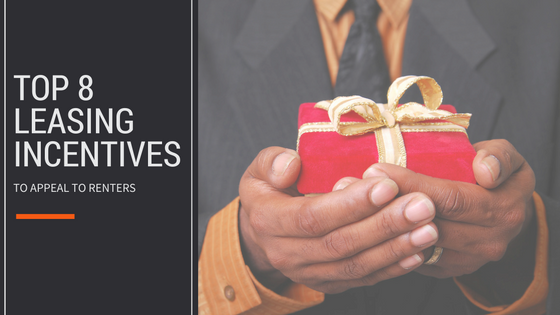As any business owner knows, sometimes you have to provide incentives to acquire and keep customers. The same principle applies to landlords. There is a rental property on every block, and though your unit is special, it’s not that special. To find and keep great renters, a landlord will often have to provide incentives.
Understanding the Mind of a Renter
There are four factors that all renters consider before signing or renewing a lease; Location, Price, Condition, and You. That’s right, I said you!
Since you can’t change the location but still obviously want to command a higher price, you have to provide incentives that improve the condition, convenience, or the level of customer service.
If the location and property condition are not ideal, and you’re not willing to do anything about it, you’ll then have to provide financial incentives to spark interest. Realistically, most people would live almost anywhere, and in less-than-favorable conditions, if the rent were low enough.
Types of Incentives
…No one should get a prize for doing what is expected of them in the lease.
With that said, no one should get a prize for doing the bare minimum or fulfilling what is expected of them in the lease, either. Whether you are trying to convince an applicant to sign a lease, or encourage a great renter to renew, incentives act as the carrot at the end of the proverbial stick.
1. Early Payment Discount
A landlord should never discount the rent if a renter pays it on-time – which usually means the absolutely last possible day. However, a small discount might be in order if the renter pays rent 10, or even 15 days early.
2. Rent Decrease
Rent decreases are a great way to convince excellent renters to sign another long-term lease. For this to be profitable, you really need to run the numbers. A $50 discount for 12 months would cost $600/year. Considering vacancy and upkeep, you must ask yourself “will keeping these renters for another year save me $600?”
3. Property Upgrades
Benefiting both the landlord and renter, anything that is a permanent change to the dwelling would be considered an upgrade. Renters who view the property as their “home”, will often ask for an upgrade.
4. Flexible Lease Terms
Sometimes, the ability to break a lease with 30 day notice, or the approval to have pets, is valuable to a renter. Again, you have to weigh the risk vs. reward, but sometimes it’s worth it.
Further, allowing other flexible terms, such as the ability to sublet, will entice a new renter or keep a current one. Student renters often travel home for the summer and want the ability to sublet their room.
5. Online Rent Payments
For many people, their rent payment is the only check they write all month. They would jump at the opportunity to pay their rent online, and finally ditch their checkbook. This added convenience can make a huge difference when marketing to new renters and instantly makes your property more appealing.
6. First Month Free
Larger apartment complexes have the additional cash flow to cushion a free month worth of rent. However, often times, the 11 other months are increased by 1/11th the price to make up for it. Without realizing it, this incentive allows a renter to spread the first month’s payment over the term or the lease, but gives the impression that they are getting something for free. For better or worse, this incentive appeals to renters with little or no cash liquidity.
7. Zero or Partial Security Deposit
Waiving the deposit requirement is popular with large apartment complexes as a means to reduce vacancies, but it’s not feasible for an independent landlord. A landlord needs the deposit as security against unpaid rent and physical damages to the unit. Without it, the landlord has no leverage or protection. Alternatively, spreading the deposit payments over the first three months will lighten the financial blow to the renter who often cannot afford to pay for first month’s rent and the deposit at the same time. However, it might not be wise to rent to someone who can’t pay the deposit in full.
8. Anything They Want (within reason)
Last but not least, perhaps it’s best to let the renter request the incentive. You just never know what they are thinking. For example, if they don’t have transportation, perhaps you could let them borrow your bike for the year. Or, maybe providing a partially furnished unit, or an early move-in date, would convince them to sign a lease.
At the end of the day, every landlord needs to market creatively to attract the best possible renters, and to keep the ones who care for the property and pay rent on time.
Many times, it’s the incentives that provide the extra push needed to seal the deal.
What incentives have you provided to your applicants or tenants? Let’s grow this list together. Share your thoughts in the comments below.
Curated from: Landlordology
There are four factors that all renters consider before signing or renewing a lease; Location, Price, Condition, and You. That’s right, I said you!
Since you can’t change the location but still obviously want to command a higher price, you have to provide incentives that improve the condition, convenience, or the level of customer service.
If the location and property condition are not ideal, and you’re not willing to do anything about it, you’ll then have to provide financial incentives to spark interest. Realistically, most people would live almost anywhere, and in less-than-favorable conditions, if the rent were low enough.
Types of Incentives
…No one should get a prize for doing what is expected of them in the lease.
With that said, no one should get a prize for doing the bare minimum or fulfilling what is expected of them in the lease, either. Whether you are trying to convince an applicant to sign a lease, or encourage a great renter to renew, incentives act as the carrot at the end of the proverbial stick.
1. Early Payment Discount
A landlord should never discount the rent if a renter pays it on-time – which usually means the absolutely last possible day. However, a small discount might be in order if the renter pays rent 10, or even 15 days early.
2. Rent Decrease
Rent decreases are a great way to convince excellent renters to sign another long-term lease. For this to be profitable, you really need to run the numbers. A $50 discount for 12 months would cost $600/year. Considering vacancy and upkeep, you must ask yourself “will keeping these renters for another year save me $600?”
3. Property Upgrades
Benefiting both the landlord and renter, anything that is a permanent change to the dwelling would be considered an upgrade. Renters who view the property as their “home”, will often ask for an upgrade.
4. Flexible Lease Terms
Sometimes, the ability to break a lease with 30 day notice, or the approval to have pets, is valuable to a renter. Again, you have to weigh the risk vs. reward, but sometimes it’s worth it.
Further, allowing other flexible terms, such as the ability to sublet, will entice a new renter or keep a current one. Student renters often travel home for the summer and want the ability to sublet their room.
5. Online Rent Payments
For many people, their rent payment is the only check they write all month. They would jump at the opportunity to pay their rent online, and finally ditch their checkbook. This added convenience can make a huge difference when marketing to new renters and instantly makes your property more appealing.
6. First Month Free
Larger apartment complexes have the additional cash flow to cushion a free month worth of rent. However, often times, the 11 other months are increased by 1/11th the price to make up for it. Without realizing it, this incentive allows a renter to spread the first month’s payment over the term or the lease, but gives the impression that they are getting something for free. For better or worse, this incentive appeals to renters with little or no cash liquidity.
7. Zero or Partial Security Deposit
Waiving the deposit requirement is popular with large apartment complexes as a means to reduce vacancies, but it’s not feasible for an independent landlord. A landlord needs the deposit as security against unpaid rent and physical damages to the unit. Without it, the landlord has no leverage or protection. Alternatively, spreading the deposit payments over the first three months will lighten the financial blow to the renter who often cannot afford to pay for first month’s rent and the deposit at the same time. However, it might not be wise to rent to someone who can’t pay the deposit in full.
8. Anything They Want (within reason)
Last but not least, perhaps it’s best to let the renter request the incentive. You just never know what they are thinking. For example, if they don’t have transportation, perhaps you could let them borrow your bike for the year. Or, maybe providing a partially furnished unit, or an early move-in date, would convince them to sign a lease.
At the end of the day, every landlord needs to market creatively to attract the best possible renters, and to keep the ones who care for the property and pay rent on time.
Many times, it’s the incentives that provide the extra push needed to seal the deal.
What incentives have you provided to your applicants or tenants? Let’s grow this list together. Share your thoughts in the comments below.
Curated from: Landlordology

